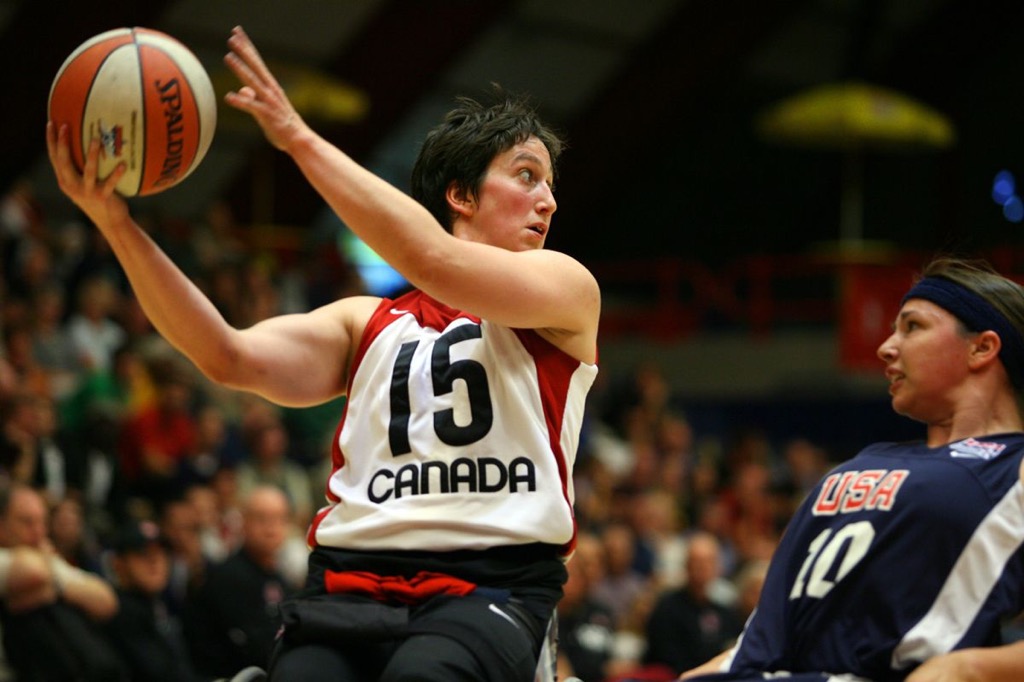During their wheelchair basketball career, Danielle Peers was always keeping their eye on the whole game: Who’s on the court? Where are the open spaces between player, ball and net? What’s in the way, and how can we get through?
Off the court, Peers has taken the same approach—identifying barriers and finding collaborators who want to work with them to create more open spaces.
Even before their playing career, “I really came to think of identity as quite culturally constructed,” says Peers—an understanding that first came through their explorations of gender and queerness; then disability.
So, in their time on the basketball court and ever since, Peers has been changing the culture; fighting for justice, safety and thriving for queer, trans, disabled and otherwise marginalized athletes in sport.
For their “transformative impact [that] changed the conversation surrounding queer people and people living with disabilities in Canadian sport and culture,” Peers was named to the Canadian Order of Sport this fall.
It’s an honour that reflects not only Peers’s 2004 Paralympic bronze medal and their host of Canadian and international championship titles, but the advocacy work that has followed them through their playing and coaching days to their career as an artist, community organizer and associate professor at the University of Alberta, where they serve as Canada Research Chair in disability and movement cultures.
“It means a lot to me that part of the rationale for my naming [to the Order of Sport] was not just the athletic accomplishments, but the things I’ve done to critique and try to change and challenge sport ever since,” says Peers. “Some of this story is about my being one of the first out-out, out-on-the-street out, willing-to-talk-about-it out athletes at that level at the time. This is not only about putting a leather-slash-rubber round thing into an iron hoop. It’s connected to things that I hope will impact people’s life chances.”
In all the celebrations around the Order of Sport, Peers’s “life partner, co-parent and co-conspirator” Lindsay Eales was proud to hear about the impact Peers had made—and continues to make—on the people around them.
“Almost everybody commented on how Danielle has really witnessed people and made them feel more themselves,” says Eales. “It’s their heart and their spirit that really drives their work across sport, academic, artistic and activist activities. They have this incredible way of combining a kind of unflinching political engagement with meeting people where they are, and working together to find ways forward.”
Growing up in an athletic family in Edmonton, Peers fell in love with basketball—“stand-up basketball,” they specify; no wheelchairs involved.
But in their last college basketball game, playing for the MacEwan Griffins, a stranger involved in the wheelchair basketball community—having seen Peers “limp up and down the court,” playing through the muscle imbalances that had affected them all their life—invited them to give wheelchair basketball a try.
“I thought, being an all-Canadian stand-up basketball player, I’d come out there and be any good [at wheelchair basketball], which I was not,” Peers recalls. “I always liken it to someone who is really good at ball hockey thinking they can just strap on skates and be good at [ice] hockey. So, I got my butt handed to me by a bunch of athletes, but also really fell in love with the sport.
“It was the first time in my life I had played sport when I wasn’t in pain from it.”
With a new way to fall in love with basketball, Peers was all in—and the wheelchair basketball community was ready to embrace a talented player. Peers has fond memories of athletes from opposing teams coaching them, even in the middle of a game, or helping fix their broken wheelchair on the sidelines so they could keep playing.
“I realized that this was a sport where the athletes knew they had to support the flourishing of all their members in order to support the flourishing of the game,” says Peers.
It was through wheelchair basketball, too, that Peers would ultimately get their diagnosis of muscular dystrophy.
“As a non-disabled athlete, I could never have played at the international level,” they say. “But at my second national [tournament], a classifier saw me—I have a very characteristic walk—and came up to me and asked what my disability was. I said ‘I don’t have one!’ And then she laughed and asked if I’d seen a neurologist.
“And you can just imagine me in the doctor’s office, getting this ‘really difficult news’ of a diagnosis, and me just smiling ear to ear, thinking, ‘Hey, I get to play on the national team now!’”
Since that day, Peers’s evolving understanding of their disability and gender has taken them on a path they had never expected through the highest levels of sport and beyond.
Fellow Canadian Paralympian Stephanie Dixon says Peers’s insights into disability and queer identity have been transformative—for the broad culture of Canadian sport, and for Dixon themself. The two were both on Canada’s 2004 Paralympian team, with Peers playing wheelchair basketball and Dixon winning one gold, six silver, and one bronze in swimming events. Now, Peers is a mentor to Dixon, who has also gone into academia in their post-Paralympic career.
“In all the areas—whether it’s the arts or academia or deconstructing gender or inspiration porn and Paralympians—Danielle is giving words to things and feelings that we’ve been struggling with,” says Dixon. “They are showing us ways of understanding ourselves in a much more deep and rich and nuanced way that blows these narrowing discourses wide open.”
“Peers knew that they wouldn’t be able to hide their queerness on the court—they had to bring their whole self to the game.”
But in the mid-2000s, when Peers was playing and coaching, they knew it wasn’t safe to be out as a queer or non-binary athlete—universities had rules on the books about not hiring gay coaches, and gender nonconforming athletes were often mocked or harassed by coaches and fellow players.
Still, there were other queer athletes whom Peers got to know over the years—players who were “out in the bedroom” or “out in the living room” with their queer loved ones and communities, but mostly kept that part of their lives separate from their athletic career.
When Peers’s fellow queer athletes quietly made themselves known and invited Peers into friendly, supportive spaces, it was a vital message that “there are athletes like you here, and you are welcome,” they say.
“I was lucky to have people like that, and people who were already out in the sport,” says Peers. “I think we tend to imagine trail-blazers as the folks who are out and proud and waving flags. We don’t think about the kinds of things that queer folks who don’t have that security do to support each other in these environments that had long been unsafe.”
But for themself, Peers knew that they wouldn’t be able to hide their queerness on the court—they had to bring their whole self to the game.
“I don’t think I could have lived, or played, while hiding that much of myself,” says Peers. “There was always a bit of tension there, and I was told not to be out, because I wouldn’t get sponsors. But at that point it didn’t feel like a choice. I had a significant relationship that I was in, and erasing them felt off the table for me. So I wasn’t going to perform in a way that was as quiet and hidden and heteronormative as had been expected of me.”
Peers says Canada has a long history of mixed-gender wheelchair basketball leagues— including one they co-founded, the Edmonton Inferno—and over their international sporting career, they played in both women’s and men’s high-level leagues. As part of the Alberta Northern Lights team—which until their joining was an entirely men’s team—they helped the Northern Light become the first Canadian team to win the 2005 National Wheelchair Basketball Association title.
“When I played on the men’s team down in the States, who won the Division II championship, I was playing against these athletes who’d ask, ‘Who’s that young boy you have playing?’ And later on, when they found out that might not be my gender, they were being quite aggressive about it,” says Peers. “But, in some ways, that really played to my advantage; the fact that they underestimated me made it easier to beat them.
“It was not smooth sailing. There was certainly a lot of resistance. But for the most part, athletes on the team were supportive of me doing what I did, because it helped them win.”
Though Peers says the culture around queer athletes is changing “to some degree” from when they played, there is much more work to be done.
“I think the vast majority of gay- or queer-identified athletes don’t make it in sport,” says Peers. “The locker rooms, those early entries into sport, are so unsafe that they don’t make it through. I think folks who either come to it later, or who can pass for some period of time, can sometimes last for much longer.
“There are certainly more out athletes now, but a lot of athletes don’t make it that far—for most folks, it’s still a very inaccessible thing.
“And with increased anti-trans laws happening both internationally and locally in sports clubs, this is not something that is progressing. This is something that we have to fight to even maintain, and to push to have more affirming relationships with.””
So, as Peers watches these slow changes and reflects back on their experiences in wheelchair sport—the good and the bad, the affirming and the hostile—it motivates them to keep working to make it possible for all athletes to find their place on the court.
“We’re dealing with safety,” says Peers. “This is my dream: when we think about what we know about trans and queer youth, and incidences of self-harm, we know that having one supportive and affirming adult is massively important to their well-being and flourishing. Just one. And in my generation of people, you hear a lot of people talk about it being their drama teacher, or their English teacher. I’ve never once heard ‘coach.’
“I would love to imagine a world in which sport and recreation could be that place, and people are saying, ‘My coach is that person.’ But we’ve got a ways to go before that is a more common story.”


 Why you can trust Xtra
Why you can trust Xtra


